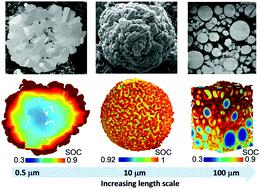当前位置:
X-MOL 学术
›
Energy Environ. Sci.
›
论文详情
Our official English website, www.x-mol.net, welcomes your
feedback! (Note: you will need to create a separate account there.)
Multi-length scale microstructural design of lithium-ion battery electrodes for improved discharge rate performance
Energy & Environmental Science ( IF 32.4 ) Pub Date : 2021-09-17 , DOI: 10.1039/d1ee01388b Xuekun Lu 1, 2, 3 , Xun Zhang 4 , Chun Tan 1, 3 , Thomas M. M. Heenan 1, 3 , Marco Lagnoni 5 , Kieran O'Regan 3, 6 , Sohrab Daemi 1 , Antonio Bertei 5 , Helen G. Jones 2 , Gareth Hinds 2 , Juyeon Park 2 , Emma Kendrick 3, 6 , Dan J. L. Brett 1, 3 , Paul R. Shearing 1, 3
Energy & Environmental Science ( IF 32.4 ) Pub Date : 2021-09-17 , DOI: 10.1039/d1ee01388b Xuekun Lu 1, 2, 3 , Xun Zhang 4 , Chun Tan 1, 3 , Thomas M. M. Heenan 1, 3 , Marco Lagnoni 5 , Kieran O'Regan 3, 6 , Sohrab Daemi 1 , Antonio Bertei 5 , Helen G. Jones 2 , Gareth Hinds 2 , Juyeon Park 2 , Emma Kendrick 3, 6 , Dan J. L. Brett 1, 3 , Paul R. Shearing 1, 3
Affiliation

|
Fast discharge capability of automotive batteries not only affects the acceleration and climbing performance of electric vehicles, but also the accessible driving range under complex driving cycles. Understanding the intricate physical and chemical processes across multiple length-scales is critical to assist the strategic design of electrodes for improved rate performance. Here, we correlate the discharge rate performance of Ni-rich LiNi1−x−yCoxMnyO2 (NMC) cathodes to the electrode architectures, ranging from the crystallographic orientations, surface morphology and cracks at single particle level, to the factors that affect the dominance of the solid and liquid-state transport (SST and LST) at electrode level. A random orientation of the primary particles is found to incur an increase of the SST resistance by a factor of 2.35 at 5C and a heterogeneous intra-particle lithiation. Internal cracks significantly restrict the accessibility to the active material. Double-layered particles are proved to be a more promising candidate than single-crystal particles. At electrode level, the SST-dominance depth is quantified for the first time to guide the microstructural tuning and rational operating windows are proposed for electrodes of various architectures. The reaction front is observed to shuttle across the electrode depth to mitigate the polarization, which can provide valuable insights into the battery management development. Finally, by comparing the performance of single crystal and polycrystalline NMC811 electrodes, it is suggested that electrode thickness and porosity are more critical in the former for enhanced discharge rate performance, in contrast to polycrystalline electrodes, in which a gradient particle fraction and size distribution are recommended.
中文翻译:

锂离子电池电极的多尺度微观结构设计,以提高放电倍率性能
汽车电池的快速放电能力不仅影响电动汽车的加速和爬坡性能,而且影响复杂驾驶循环下的可行驶里程。了解跨多个长度尺度的复杂物理和化学过程对于协助电极的战略设计以提高倍率性能至关重要。在这里,我们关联了富镍 LiNi 1− x − y Co x Mn y O 2的放电倍率性能(NMC) 阴极到电极结构,从单粒子水平的晶体取向、表面形态和裂纹,到影响电极水平的固态和液态传输(SST 和 LST)优势的因素。发现初级粒子的随机取向会导致 SST 电阻在 5C 下增加 2.35 倍,并导致粒子内不均匀的锂化。内部裂纹显着限制了活性材料的可及性。双层颗粒被证明是比单晶颗粒更有希望的候选者。在电极级别,首次量化了 SST 优势深度以指导微结构调整,并为各种结构的电极提出了合理的操作窗口。观察到反应前沿穿梭于电极深度以减轻极化,这可以为电池管理开发提供有价值的见解。最后,通过比较单晶和多晶 NMC811 电极的性能,表明电极厚度和孔隙率在前者中对于提高放电倍率性能更为关键,而多晶电极则相反,其中梯度粒子分数和尺寸分布是受到推崇的。
更新日期:2021-09-27
中文翻译:

锂离子电池电极的多尺度微观结构设计,以提高放电倍率性能
汽车电池的快速放电能力不仅影响电动汽车的加速和爬坡性能,而且影响复杂驾驶循环下的可行驶里程。了解跨多个长度尺度的复杂物理和化学过程对于协助电极的战略设计以提高倍率性能至关重要。在这里,我们关联了富镍 LiNi 1− x − y Co x Mn y O 2的放电倍率性能(NMC) 阴极到电极结构,从单粒子水平的晶体取向、表面形态和裂纹,到影响电极水平的固态和液态传输(SST 和 LST)优势的因素。发现初级粒子的随机取向会导致 SST 电阻在 5C 下增加 2.35 倍,并导致粒子内不均匀的锂化。内部裂纹显着限制了活性材料的可及性。双层颗粒被证明是比单晶颗粒更有希望的候选者。在电极级别,首次量化了 SST 优势深度以指导微结构调整,并为各种结构的电极提出了合理的操作窗口。观察到反应前沿穿梭于电极深度以减轻极化,这可以为电池管理开发提供有价值的见解。最后,通过比较单晶和多晶 NMC811 电极的性能,表明电极厚度和孔隙率在前者中对于提高放电倍率性能更为关键,而多晶电极则相反,其中梯度粒子分数和尺寸分布是受到推崇的。











































 京公网安备 11010802027423号
京公网安备 11010802027423号